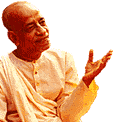Chapter 2: Contents of the Gita Summarized
Bg 2.1
TEXT 1
sanjaya uvaca
tam tatha krpayavistam
asru-purnakuleksanam
visidantam idam vakyam
uvaca madhusudanah
tam tatha krpayavistam
asru-purnakuleksanam
visidantam idam vakyam
uvaca madhusudanah
SYNONYMS
sanjayah uvaca—Sanjaya said; tam—unto Arjuna; tatha—thus; krpaya—by compassion; avistam—overwhelmed; asru-purna—full of tears; akula—depressed; iksanam—eyes; visidantam—lamenting; idam—this; vakyam—words; uvaca—said; madhusudanah—the killer of Madhu.
TRANSLATION
Sanjaya said: Seeing Arjuna full of compassion and very sorrowful, his eyes brimming with tears, Madhusudana, Krsna, spoke the following words.
PURPORT
Material compassion, lamentation and tears are all signs of ignorance of the real self. Compassion for the eternal soul is self-realization. The word "Madhusudana" is significant in this verse. Lord Krsna killed the demon Madhu, and now Arjuna wanted Krsna to kill the demon of misunderstanding that had overtaken him in the discharge of his duty. No one knows where compassion should be applied. Compassion for the dress of a drowning man is senseless. A man fallen in the ocean of nescience cannot be saved simply by rescuing his outward dress—the gross material body. One who does not know this and laments for the outward dress is called a sudra, or one who laments unnecessarily. Arjuna was a ksatriya, and this conduct was not expected from him. Lord Krsna, however, can dissipate the lamentation of the ignorant man, and for this purpose the Bhagavad-gita was sung by Him. This chapter instructs us in self-realization by an analytical study of the material body and the spirit soul, as explained by the supreme authority, Lord Sri Krsna. This realization is made possible by working with the fruitive being situated in the fixed conception of the real self.
Copyright (c) 1972 by His Divine Grace A.C. Bhaktivedanta Swami Prabhupada











